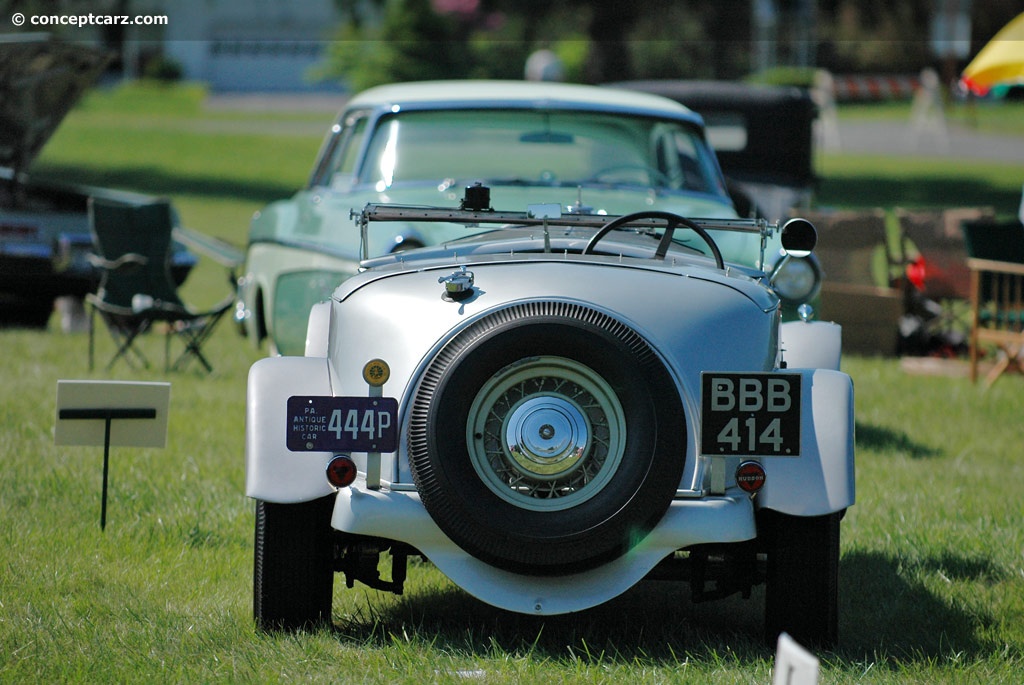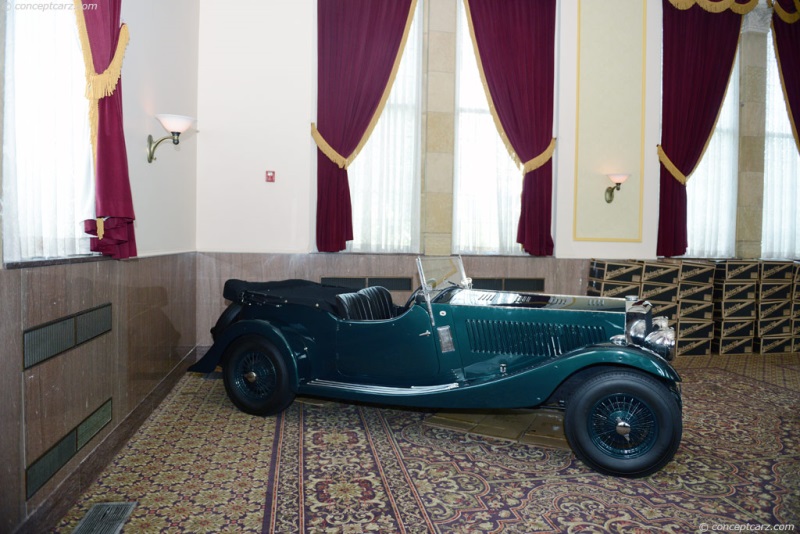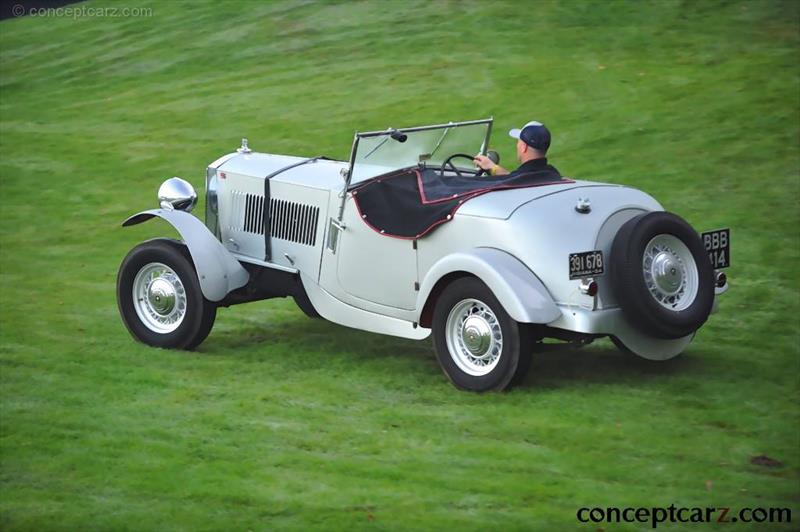The British automobile marque, Railton, was founded by Noel Macklin and Reid Railton and built using Hudson mechanical components. They were assembled at the old Invicta works on Macklin's Fairmile estate in Cobham, Surrey. The Railton automobile was introduced in 1933 and produced through 1940; an attempt was made to revive the Railton name as a new company between 1989 and 1994 in Alcester, Warwickshire.
Sports Roadster
Chassis #: S21
View info and historyReid Railton had established the Arab Motor Company in 1922 where he served as chief designer. About twelve vehicles were produced before the Arab factory closed in 1927 following the death of his friend Parry-Thomas. He moved to Brookland and got a job as Technical Director for Thomson & Taylor where he worked on John Cobb's 1933 Napier Railton car which achieved the Outer Circuit record in 1933 and designed the E.R.A. racing cars of 1933 and 1934. He also worked on Sir Malcolm Campbell's Blue Bird Land Speed Record cars from 1931 to 1935. John Cobb's 'Railton Special car' set a Land Speed Record of 394.7 mph in 1947. His talents and expertise were later applied to high-speed boat designs, including the jet-powered Crusader which attempted to break the Water Speed Record. Noel Macklin co-founded Eric-Campbell in 1919, Silver Hawk in 1920, Invicta in 1925, and Railton in 1933. Production of the Invicta automobiles took place in Macklin's garage at his home at Fairmile Cottage on the main London to Portsmouth road in Cobham, Surrey. His mechanic was William Watson who he knew from before World War I. The early Invicta models were powered by Meadows straight-six, overhead-valve engines displacing 2½ liter and backed by a four-speed gearbox. Engine displacement size grew to 3 liters in 1926 and 4½ liters in late 1928. Hoping to appeal to a wider audience, a 1½ liter straight-six overhead-cam Blackburne engined 12/45 L-type was announced in 1932. However, the engine proved inadequate to motivate the nearly 10-foot long-wheelbase chassis. A supercharged 12/90 model arrived in 1933, boosting output from 45 to 90 bhp. The Invicta vehicles were attractive and sporty, offering versatility through the various wheelbase sizes and engine choices. Noel Macklin's sister-in-law, Violette Cordery, was responsible for much of Invicta's sporting success, including earning the Dewar Trophy on two occasions. Between February and July 1927 she drove an Invicta around the world, accompanied by a nurse, a mechanic, and an RAC observer. She broke four world and 33 Italian records at Monza.
Sports Roadster
Chassis #: S21
View info and historyThe Great Depression of the early 1930s resulted in economic hardship throughout the world, and like Bentley, Invicta struggled against rising costs and falling sales. Their final car left the factory on Friday the 13th of October 1933, though a handful of cars was assembled at the company's service depot in Flood Street, Chelsea between 1934 and 1936. The Railton Automobile
The company was named after Reid Railton to capitalize upon the popularity of the name 'Railton', the man who had engineered Malcolm Campbell's 300-mph 'Bluebird' land speed record car of the 1930s. It signified the company's goal of building high-end sports and touring cars. The earliest models were based on an eight-cylinder Terraplane chassis with bodywork by the Ranalah coachworks located in London. By 1935, the company was using the Hudson Eight chassis and offering a wider range of bodies supplied by many top British coachworks. Approximately 1,379 examples of the Railton 8s were produced, with its American-made Hudson Eight chassis and powertrain making it one of the most reliable, powerful, and durable vehicles of its era. Along with the potent 8, Railton offered smaller models built on the six-cylinder Hudson chassis and Standard Flying Nine chassis.
Sports Roadster
Chassis #: S21
View info and historyPrior to the outbreak of hostilities in Europe, Mr. Macklin sold the company in 1939 to Hudson Motor Car Company, turning his attention to powerboats. Railton vehicle production came to a close with the onset of wartime in Europe. When peacetime resumed, a new model was introduced at the 1949 London Motor Show, but it was too expensive and never entered production. Railton was out of business.The Railton 8
The Railton 8 used the Hudson Terraplane chassis until 1935 when it was replaced by the one from the Hudson Eight. The Essex Terraplane (which became just 'Terraplane' by 1934) was a 'junior' marque to Hudson before being repositioned by company executives into the Hudson fold in an effort beginning in 1937. The Essex-Terraplane was introduced in 1932 and quickly gained notoriety for its lightweight construction, combining the body and frame into a single unit. Many components throughout the vehicle served as part of the body/chassis structure. Coupled with the 193.1 cubic-inch six-cylinder engine, Hudson described the Essex-Terraplane as 'having a higher propulsion effort per pound of car weight than any production car now on the market in this country or abroad.' The Essex-Terraplane eight-cylinder engine displaced 243.9 cubic inches and had five main bearings, mechanical valve lifters, 5.8:1 compression, and a one-barrel downdraft carburetor. It had a 2.94-inch bore and 4.50-inch stroke and developed 94 horsepower at 3,600 RPM. The six-cylinder chassis sizes measured 106 and 113 inches, with the longer of those being shared with the eight-cylinder model. Both engines were backed by a three-speed sliding gear transmission with a single plate clutch and floor shift controls. Bendix mechanical brakes at all four corners provided the stopping power.
Sports Roadster
Chassis #: S21
View info and historyDuring 1932 and 1933, stock Terraplanes set 72 hill climb and speed records, with a Terraplane 8 achieving a top speed of 85 mph at Daytona Beach and a zero-to-sixty mph time of under 15 seconds. In 1935, the Terraplane chassis was replaced by one from the Hudson Eight, and engine displacement size grew to 254 cubic inches with horsepower reaching 113 bhp at 3,800 RPM. The L-head engine had a chrome alloy block, five main bearings, and a 6.0:1 compression ratio. Hudson offered an optional, higher output version of the engine which brought horsepower to 124 bhp. Since Railton did not have coachbuilding capability, all Railton 8 models wore coach-built bodies. Among them were Carbodies, Coachcraft Ltd., R.E.A.L., and Ranalah.
by Daniel Vaughan | Mar 2022

Sports Roadster
Chassis #: S21
View info and history

Sports Roadster
Chassis #: S21
View info and history
The company was named after Reid Railton to capitalize upon the popularity of the name 'Railton', the man who had engineered Malcolm Campbell's 300-mph 'Bluebird' land speed record car of the 1930s. It signified the company's goal of building high-end sports and touring cars. The earliest models were based on an eight-cylinder Terraplane chassis with bodywork by the Ranalah coachworks located in London. By 1935, the company was using the Hudson Eight chassis and offering a wider range of bodies supplied by many top British coachworks. Approximately 1,379 examples of the Railton 8s were produced, with its American-made Hudson Eight chassis and powertrain making it one of the most reliable, powerful, and durable vehicles of its era. Along with the potent 8, Railton offered smaller models built on the six-cylinder Hudson chassis and Standard Flying Nine chassis.

Sports Roadster
Chassis #: S21
View info and history
The Railton 8 used the Hudson Terraplane chassis until 1935 when it was replaced by the one from the Hudson Eight. The Essex Terraplane (which became just 'Terraplane' by 1934) was a 'junior' marque to Hudson before being repositioned by company executives into the Hudson fold in an effort beginning in 1937. The Essex-Terraplane was introduced in 1932 and quickly gained notoriety for its lightweight construction, combining the body and frame into a single unit. Many components throughout the vehicle served as part of the body/chassis structure. Coupled with the 193.1 cubic-inch six-cylinder engine, Hudson described the Essex-Terraplane as 'having a higher propulsion effort per pound of car weight than any production car now on the market in this country or abroad.' The Essex-Terraplane eight-cylinder engine displaced 243.9 cubic inches and had five main bearings, mechanical valve lifters, 5.8:1 compression, and a one-barrel downdraft carburetor. It had a 2.94-inch bore and 4.50-inch stroke and developed 94 horsepower at 3,600 RPM. The six-cylinder chassis sizes measured 106 and 113 inches, with the longer of those being shared with the eight-cylinder model. Both engines were backed by a three-speed sliding gear transmission with a single plate clutch and floor shift controls. Bendix mechanical brakes at all four corners provided the stopping power.

Sports Roadster
Chassis #: S21
View info and history
by Daniel Vaughan | Mar 2022
Related Reading : Railton Eight History
The Railton automobile was produced between 1933 and 1940 and built by Fairmile Engineering Company in Cobham, Surrey. The place where the Railtons were produced was the same location where the Invicta cars had been built. The Invicta Company had been started by Noel Macklin (Sir Albert Noel Campbell Macklin). Mr. Macklin had a history of building cars and as a boat designer. His companies included....
Continue Reading >>
Continue Reading >>
Railton
1934 Railton Eight Vehicle Profiles
Recent Vehicle Additions
Performance and Specification Comparison
Eight Specification Comparison by Year
Year
Production
Wheelbase
Engine
Prices
Related Automotive News

The W8 Passat
Herndon, VA — Volkswagen has a long and storied history of developing powertrains unique for their performance, technology, efficiency, and design. Such was the case in the late 1990s when VW offered its W engine in a series of concept supercars...

Audi Introduces 2020 E-Tron Sportback, All-New RS Models, And S Models At Los Angeles Auto Show
Global debut of Audi e-tron Sportback, second fully electric production model from Audi of America
First-ever RS Q8 makes world debut at Los Angeles Auto Show, November 20
New suite of RS models includes all-new Audi RS 6 Avant and RS 7
LOS A...

High-Performance Audi S8 To Debut At Los Angeles Auto Show, 2020 A8 Model Line Expanded
All-new 2020 S8 joins model line blending S model performance with the comfort of a long-wheelbase
2020 A8 luxury sedan receives 4.0-liter V8 engine offering with elevated torque and more usable power
Audi continues committment to electrification...

Mercedes-Benz at the 2017 New York International Auto Show : Two world premieres and two U.S. premieres deliver a sporting edge
Fuel consumption combined 10.7-10.3 l100 km combined CO2 emissions 244-234 gkm
At this years New York International Auto Show (NYIAS), Mercedes-Benz is following seamlessly on from its dynamic appearances at the motors shows in Detroit...

THE NEW AMG 4.0-LITER V8 BITURBO ENGINE
Powerful, innovative and efficient
July 25, 2014 - Affalterbach -- Mercedes-AMG presents a new technological masterpiece the AMG 4.0-liter V8 biturbo engine is a new development at the sporting heart of the new Mercedes-AMG GT car. This...

























